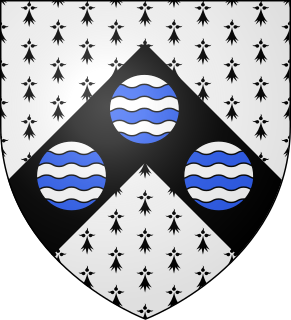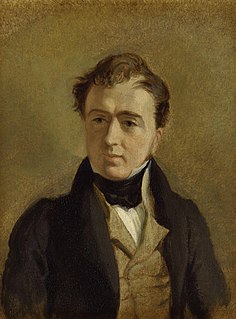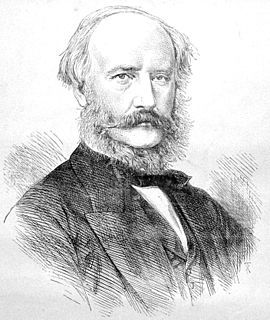Related Research Articles

Viscount Cobham is a title in the Peerage of Great Britain that was created in 1718. Owing to its special remainder, the title has passed through several families. Since 1889, it has been held by members of the Lyttelton family.
Earl of Meath is a title in the Peerage of Ireland created in 1627 and held by the head of the Brabazon family. This family descends from Sir Edward Brabazon, who represented County Wicklow in the Irish House of Commons and served as High Sheriff of Staffordshire in 1606. In 1616 he was raised to the Peerage of Ireland as Baron Ardee. He was succeeded by his eldest son, the second Baron. In 1627 he was created Earl of Meath in the Peerage of Ireland, with remainder to his younger brother the Hon. Sir Anthony Brabazon. Lord Meath was succeeded by his son, the second Earl. His grandson, the fourth Earl, served as Lord-Lieutenant of Dublin and of Kildare. He died childless and was succeeded by his younger brother, the fifth Earl. He was also Lord-Lieutenant of Dublin. Lord Meath married the Hon. Juliana, daughter of Patrick Chaworth, 3rd and last Viscount Chaworth.

Earl of Lonsdale is a title that has been created twice in British history, firstly in the Peerage of Great Britain in 1784, and then in the Peerage of the United Kingdom in 1807, both times for members of the Lowther family.

Earl of Rosse is a title that has been created twice in the Peerage of Ireland; both times for the Parsons family.

Viscount Scarsdale, of Scarsdale in the County of Derby, is a title in the Peerage of the United Kingdom. It was created in 1911 for the prominent Conservative politician and former Viceroy of India George Curzon, 1st Baron Curzon of Kedleston, who was created Earl Curzon of Kedleston at the same time and was later made Marquess Curzon of Kedleston.

Baron Brownlow, of Belton in the County of Lincoln, is a title in the Peerage of Great Britain. It was created in 1776 for Sir Brownlow Cust, 4th Baronet. The Cust family descends from Richard Cust (1622-1700) of The Black Friars, Stamford, who represented Lincolnshire and Stamford in Parliament. In 1677 he was created a baronet, "of Stamford in the County of Lincoln". He was succeeded by his grandson Richard Cust, 2nd Baronet, who married Anne Brownlow, daughter of Sir William Brownlow, 4th Baronet, "of Humby", Lincolnshire, and sister and sole heiress of John Brownlow, 1st Viscount Tyrconnel, 5th Baronet of Belton House, Lincolnshire. The 2nd Baronet's son Sir John Cust, 3rd Baronet, sat as a Member of Parliament for Grantham and served as Speaker of the House of Commons from 1761 to 1770 and in 1754 inherited the Brownlow estates, including Belton, on the death of his childless maternal uncle Viscount Tyrconnel. His son Brownlow Cust, 4th Baronet represented Ilchester, Somerset, and Grantham in Parliament and in 1776 was raised to the peerage as Baron Brownlow, "of Belton in the County of Lincoln", chiefly in recognition of his father's services. He was succeeded by his son John Cust, 2nd Baron Brownlow who had sat as a Member of Parliament for Clitheroe, Lancashire, and also served as Lord Lieutenant of Lincolnshire for many years. In 1815 he was created Viscount Alford, "in the County of Lincoln" and Earl Brownlow both in the Peerage of the United Kingdom. In 1810 the future 1st Earl had married Sophia Hume, a daughter of Sir Abraham Hume, 2nd Baronet, of Wormleybury, by his wife Lady Amelia Egerton, a great-granddaughter of John Egerton, 3rd Earl of Bridgewater.

Baron Inchiquin is one of the older titles in the Peerage of Ireland. It was one of two titles created on 1 July 1543 for Murrough O'Brien, Prince of Thomond, who was descended from the great high king Brian Boru. The grant of the English titles was conditional upon the abandonment of native titles, the adoption of English customs and laws, pledging of allegiance to the English crown, apostasy from the Catholic Church, and conversion to the Anglican Church. Murrough was made both Earl of Thomond in the Peerage of Ireland, with remainder to his nephew Donough O'Brien and Baron Inchiquin, with remainder to his male heirs.

Baron Hazlerigg, of Noseley in the County of Leicester, is a title in the Peerage of the United Kingdom. It was created in 1945 for Sir Arthur Hazlerigg, 13th Baronet. He had previously served as Lord Lieutenant of Leicestershire. As of 2017 the titles are held by his grandson, the third Baron, who succeeded his father in 2002.

There have been three baronies created for the Gerard family who lived historically at Bryn, Ashton-in-Makerfield, Lancashire and Kingsley, Cheshire, in the 13th century. The third and current barony was created in 1876.

Baron Northbrook, of Stratton in the County of Southampton, is a title in the Peerage of the United Kingdom. It was created in 1866 for the Liberal politician and former Chancellor of the Exchequer, Sir Francis Baring, 3rd Baronet. The holders of the barony represent the genealogically senior branch of the prominent Baring family. The name Northbrook is derived from a tithing of the local parish.

Baron Burnham, of Hall Barn in the Parish of Beaconsfield in the County of Buckingham, is a title in the Peerage of the United Kingdom. It was created on 31 July 1903 for the influential newspaper magnate Sir Edward Levy-Lawson, 1st Baronet, owner of the Daily Telegraph. He had already been created a Baronet, of Hall Barn in The Parish of Beaconsfield in the County of Buckingham and of Peterborough Court in the City of London, in the Baronetage of the United Kingdom on 13 October 1892. Levy-Lawson was the son of Joseph Moses Levy, who acquired the Daily Telegraph only months after its founding.

There have been two baronetcies created for members of the Guinness brewing family, both in the Baronetage of the United Kingdom. As of 2014 both titles are extant.

The Hogg Baronetcy, of Upper Grosvenor Street in the County of London, is a title in the Baronetage of the United Kingdom. It was created on 20 July 1846 for the lawyer and Conservative politician James Hogg. He was Registrar of the Supreme Court of Judicature and Vice-Admiralty Court in Calcutta for many years and also represented Beverley and Honiton in the House of Commons. His son, the second Baronet, was Chairman of the Metropolitan Board of Works in London from 1870 to 1889. On 5 July 1887 he was created Baron Magheramorne, of Magheramorne in the County of Antrim, in the Peerage of the United Kingdom, as part of the celebrations for the Golden Jubilee of Queen Victoria. The title is pronounced "Marramorn" and derives from a historic site in County Antrim near Larne.
There have been seven baronetcies created for persons with the surname Palmer, two in the Baronetage of England, one each in the Baronetages of Ireland and of Great Britain and three in the Baronetage of the United Kingdom. Four of the creations are extant as of 2015, one of which became merged into the first grantee's later barony: Baron Palmer, the first baron being an heir to part of the Huntley & Palmers international biscuit business and a patron of music. The other current creations were awarded to a lawyer and politician of wealth under Charles II, to a South Sea Company director under George III and to a shipbuilder, shipbroker who was a Liberal statesman under Victoria.
There have been three baronetcies created for persons with the surname Lees, all in the Baronetage of the United Kingdom.

There have been three baronetcies created for persons with the surname Ball, one in the Baronetage of England and two in the Baronetage of the United Kingdom.

Glenville is a village and townland in County Cork, Ireland. It is situated approximately 20 km northeast of Cork city.

Edward Alfred Goulding, 1st Baron Wargrave, known as Sir Edward Goulding, Bt, between 1915 and 1922, was a British barrister, businessman and Conservative Party politician. He sat in the House of Commons between 1895 and 1922, before being ennobled and taking his seat in the House of Lords
The Sheriff of County Dublin was the Sovereign's judicial representative in County Dublin. Initially an office for lifetime, assigned by the Sovereign, the Sheriff became an annual appointment following the Provisions of Oxford in 1258. Besides his judicial importance, the sheriff had ceremonial and administrative functions and executed High Court Writs.
The Very Rev. John Alexander, MA was an Irish Anglican priest who served as Dean of Ferns from 1899 until his death in 1908.
References
- ↑ "No. 25741". The London Gazette . 23 September 1887. p. 5098.